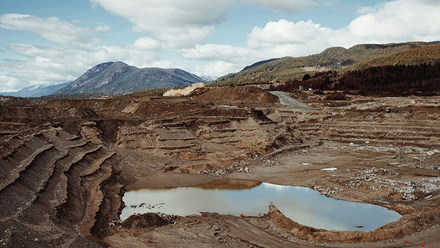Greening the black: Could abandoned mines provide a source of low carbon heat?
Charlotte Adams, Commercial Manager at The Coal Authority and Professor Jon Gluyas of Durham University, debate the potential of retired coal mines as a future heat source.

The UK became the first nation to abandon its deep coal mines following a political decision during the 1980s that led to rapid mine abandonment across the country. This created high levels of unemployment and social deprivation in mining areas and many communities were further affected by rising water levels underground that threatened to contaminate surface and groundwater.
Now, mine water pumps and treatment systems operate at strategic locations across the UK. These pumps control water levels across the former coalfield areas to intercept and treat any potentially problematic mine water discharges. While this solves the problem of mine water pollution, it comes at a cost to the UK taxpayer and some former mining areas retain high levels of social deprivation.
An opportunity exists to re-use abandoned mining infrastructure as a source of low carbon geothermal heat, which in turn could help deliver economic and environmental improvements for places that helped to deliver the UK’s industrial and economic growth.
Over 15 billion tonnes of coal were mined from the UK subsurface over the past century. The mined coal has long since been traded and burned, yet the water that has flowed into the mines and filled voids left by the coal contains geothermal heat – a sustainable source of energy. The tepid waters in flooded abandoned mines could therefore be used several times over as low-carbon heat. As a source of geothermal energy, for use in cooling and as vessels for interseasonal energy storage, the UK’s abandoned mines have the potential to sustainably meet all the heating requirements of the coalfield areas.
As many towns and cities in the UK were developed as a direct result of their coal reserves, there is also a good overlap between coalfield areas and heat demand. Around one quarter of UK homes and businesses are in coalfield areas, meaning there is potential to access this energy source.
Hands to the pump
The UK deep geothermal industry has been slow to develop, not for lack of potential but because of the upfront capital cost and risk associated with drilling boreholes to depths of 1km or more to access temperatures of 60°C plus. However, mine energy provides an opportunity to de-risk UK geothermal and promote the development of this industry.
Although the water in abandoned mines is cooler than in a deep geothermal project, much more is known about the mining infrastructure and copious quantities are present. The man-made shafts and galleries provide structures through which water can flow.
This means risk and cost is reduced as shallower boreholes – typically a few 100m – are required and permeable structures are the target.
The trade-off is that the water within the mines is tepid, at temperatures of 12-20°C. Clearly this is not hot enough for domestic purposes, but by using a heat pump temperatures can be increased to a more comfortable 40-50°C. The heat pump requires an electrical input but it is an energy efficient device because you can expect to get 3-4kW of heat output from the heat pump for every 1kW of electrical input. As the carbon content of electricity decreases with the greening of the grid, carbon emissions reduce and the UK’s abandoned mines could make a significant contribution to decarbonising the UK’s heat demand for many years to come.
To put this within the context of the UK energy landscape, over half of UK energy demand is currently used to produce heat, much of which is consumed by the domestic sector. Most of this is provided by burning gas. The UK has been a net importer of gas for over a decade which has created dependencies on other nations to maintain supplies. In addition to improving our energy security, we also need to decarbonise our energy supplies to meet carbon reduction targets and combat climate change.

Mine energy is accessed by drilling boreholes into the workings to abstract the mine water. Around 5°C is removed by passing it through a heat exchanger that interfaces with a heat pump, before the cooled water is reinjected to the workings. It is normal practice to abstract from a deeper seam and re-inject to a shallower one. To develop these schemes, it is necessary to seek permission from The Coal Authority, who owns the subsurface infrastructure and has experience of drilling through mined terrain. It is also important to have a good understanding of how the mines are configured to increase the chance of finding a good flow of water.
There are around 30 mine energy projects globally that operate at a range of scales and supply a variety of end users from both operational and abandoned mines. This means that mine energy can be a very versatile heat source, but this can also make it difficult to take a one size fits all approach to development as its deployment is led by the nature and extent of the underlying mine workings.
Technology readiness
One very successful large-scale mine energy heat network has been operating at Heerlen in the Netherlands for over a decade. This scheme delivers heating and cooling to 200,000m² of mixed use new and retrofit buildings through a 7km heat network. This project has enabled economic regeneration through revenue from heat sales being retained within the region rather than going to a national energy supplier.
In Poland, water pumped from an operational coal mine is used with heat pumps to heat the pithead baths where the miners wash at the end of their shifts. While in Spain, mine water is currently being used from the Barredo mine in Mieres to heat a hospital.
In the Tyne and Wear region of the UK, a commercial mine energy system now operates at Lanchester Wines. This provides around 4MW of heating for two warehouses and is understood to be the largest geothermal heat system in the UK.
Decarbonising heat
So, given their versatility, why is it that mine energy systems are not used more widely? There are a range of reasons for this, including access to cheap and plentiful gas supplies and risk averse attitudes to ‘untested technology’.
There are also complexities associated with retrofitting heat exchangers and heat pumps and economic risks relating to securing long-term contracts for heat supply. However, the declaration of climate emergencies across many regions of the UK, government intentions to reduce the number of new gas connections from 2025, and a desire to increase the amount of heat supplied by heat networks means that the time is right to consider mine energy as part of the solution for decarbonising heat. Mine energy is also at a much higher state of technology readiness than other low-carbon heat sources such as hydrogen.
The North of England Institute of Mining and Mechanical Engineers (NEIMME) has presided over many innovations and advancements in mining technology and the reopening of Neville Hall in 2020 coincides with the renaissance of the UK coalfields as a source of energy. During his presidential inaugural lecture to NEIMME during the 1870s, Lord Armstrong reflected on the profligacy of burning coal on open fires due to the amount of heat lost to chimneys, he also recognised that coal was a finite resource. It is amazing to think that the infrastructure so hard won by past generations to meet the growing need for energy and industrialisation could now provide a low-carbon source of heat for the future generations.
In numbers
75
Total number of UK mine water treatment schemes managed by The Coal Authority. Over 122bln litres of water is currently handled and treated.
>80MW
Approximate amount of heat generated from water that is pumped from the UK’s abandoned mines.
25%
Amount of UK homes that currently overlie coalfield areas and could potentially access this resource.







